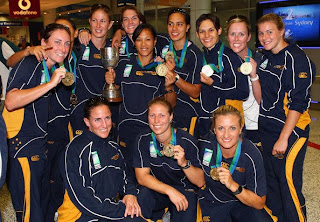

Rugby union, or simply Rugby, is a full contact team sport, a form of football which originated in England in the early 19th century.One of the codes of rugby football, it is based on running with the ball in hand. It is played with an oval-shaped ball, outdoors on a level field, usually with a grass surface, up to 100 metres (330 ft) long and 70 metres (230 ft) wide.On each goal line are H-shaped goal posts.
William Webb Ellis is often credited with the invention of running with the ball in hand in 1823 at Rugby School when he allegedly caught the ball while playing football and ran towards the opposition goal. Although the evidence to support the Ellis story is doubtful, it was immortalised at the school with a plaque unveiled in 1895.In 1848, the first rules were written by pupils;other significant events in the early development of rugby include the Blackheath Club's decision to leave the Football Association in 1863 and the split between rugby union and rugby league in 1895.
The International Rugby Board (IRB) has been the governing body for rugby union since its formation in 1886. Currently, 115 national unions are members of the IRB. In 1995, the IRB removed restrictions on payments to players, making the game openly professional at the highest level for the first time.

The winner of the world cup 2007, South Africa
The Rugby World Cup, first held in 1987, takes place every four years, with the winner of the tournament receiving the Webb Ellis Cup. The Six Nations in Europe and the Tri Nations in the southern hemisphere are major international competitions held annually. Major domestic competitions include the Top 14 in France, the Aviva Premiership in England, the Currie Cup in South Africa, and the ITM Cup in New Zealand. Other transnational competitions include the Magners League, involving Irish, Scottish and Welsh teams (and Italian teams from 2010–11); the Super 14 (to become the Super 15 in 2011), involving South African, Australian and New Zealand teams; and the Heineken Cup, involving the top European teams from their respective domestic competitions.
Women's Rugby


Women's All Black Team
Records of women's rugby football go back to the late 19th century, with the first documented source being Emily Valentine's writings, stating that she set up a rugby team in Portora Royal School in Enniskillen, Ireland in 1887.Although there are reports of early women's matches in New Zealand and France, one of the first notable games to prove primary evidence was the 1917 war-time encounter between Cardiff Ladies and Newport Ladies; a photo of which shows the Cardiff team before the match at the Cardiff Arms Park.In the past 30 years the game has grown in popularity among female athletes, and, according to England's RFU, is now played in over 80 countries.
The English Rugby Football Union for Women (RFUW) was founded in 1983, and is the oldest formally organised national governing body for women's rugby.

Australia Women's Team









